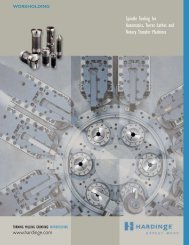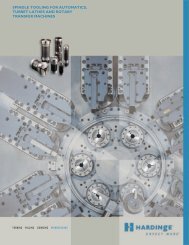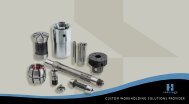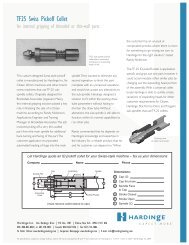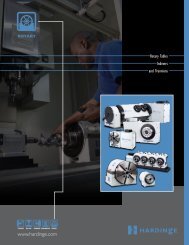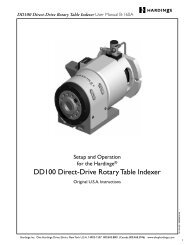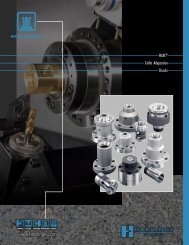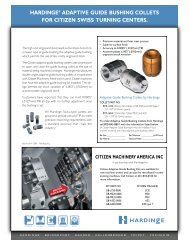You also want an ePaper? Increase the reach of your titles
YUMPU automatically turns print PDFs into web optimized ePapers that Google loves.
<strong>Sure</strong>-Grip ® <strong>Power</strong> <strong>Chuck</strong> Safety and Technical Manual B-87Z<br />
GUIDELINES FOR USING POWER OPERATED CHUCKS<br />
When mounting the Hardinge ® <strong>Sure</strong>-Grip ® <strong>Chuck</strong> on a lathe for heavy-duty machining at high spindle speeds, certain<br />
criteria must be taken into consideration to ensure safe operation of the chuck as well as the machine tool.<br />
Machine tools other than Hardinge may require an actuating cylinder and draw bar to operate the chuck. The following<br />
safety requirements must be met for these configurations as well as those mounted on Hardinge lathes. Make sure the<br />
machine tool has the following features before mounting the Hardinge <strong>Sure</strong>-Grip <strong>Chuck</strong>, and that each of these features<br />
function properly.<br />
• Spindle Start: The spindle cannot be allowed to rotate until the clamping pressure has built up in the actuating<br />
cylinder and the clamping has taken place.<br />
• Open <strong>Chuck</strong>: The chuck may not be opened until the spindle has come to a complete stop.<br />
• Hydraulic or Pneumatic <strong>Power</strong> Failure: The workpiece must stay firmly gripped in the chuck jaws until the<br />
spindle has come to a complete stop.<br />
• Electrical <strong>Power</strong> Failure: After an electrical power failure, the workpiece must stay firmly gripped in the chuck<br />
jaws until the spindle has come to a complete stop. When the electricity is resumed, the chuck must still firmly<br />
grip the part so as not to release it. The user must make certain after any electrical power failure that all functions<br />
of the machine work properly before operating the chuck or the machine tool.<br />
• Draw Bar Pressure Failure: If the pressure fails going to the actuating cylinder, a signal must stop the machine<br />
spindle.<br />
• Safety Instructions: The safety instructions given in the machine tool operations manual and maintenance<br />
manual must be strictly followed. When using a second-source actuating cylinder, the safety instructions given in its<br />
operation's manual must also be strictly followed.<br />
<strong>Chuck</strong> Functioning (See ISO TR 13618 Recommendations for the User)<br />
After mounting the chuck, the following must be checked by the operator/setup person before operating the chuck on<br />
the machine tool:<br />
• Clamping Force: The clamping force found in the chuck operation manual must be obtainable at the<br />
maximum recommended draw bar force.<br />
• Stroke Safety Range: A safety stroke limit must be provided for both the forward and back positions.<br />
The machine spindle can only start after the draw bar has moved enough to safely close the chuck.<br />
• RPM Limit: The machine tool must be equipped with a speed limitation device to make certain that the spindle<br />
RPM of the machine does not exceed the maximum RPM limitations of the chuck.<br />
• Adjustable Stroke Limits: When a different size or manufacturer of chuck is mounted to the machine spindle,<br />
the draw bar stroke limit must be adjustable to meet these new specifications.<br />
• Centrifugal Force: The centrifugal force of the clamping jaws must be taken into consideration when<br />
calculating the required clamping for machining a workpiece.<br />
<strong>Chuck</strong> Maintenance<br />
The chuck will only operate properly when the maintenance instructions are precisely followed as outlined in the operation's<br />
manual for the chuck. The following practices must be followed:<br />
• Only lubricants specified in the operation's manual must be used. An unsuitable lubricant can unexpectedly<br />
reduce the clamping force dramatically. Use Chevron Ultra-Duty EP NLGI 2, Dow Corning BR-Plus, or Kluber<br />
ALTEMP Q NB 50 grease.<br />
• A pressure gun must be used to make certain that the lubricant reaches all the surfaces requiring<br />
lubrication.<br />
• The chuck must be actuated several times through its complete stroke in order for the lubricant to reach<br />
all surfaces. After this has been done, repeat the lubrication and then check the clamping force of the chuck.<br />
Hardinge Inc. One Hardinge Drive, Elmira, New York U.S.A. 14902-1507 800.843.8801 www.hardingetooling.com<br />
10



